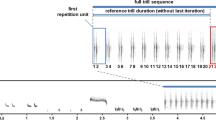Abstract
We asked whether switching among song type variants functions as a graded signal of aggression in song sparrows (Melospiza melodia). Song type variants are different versions of a given song type and are defined by much smaller acoustic differences than those defining separate song types. The principal evidence that switching between song types functions as an aggressive signal, in song sparrows and other species, is that song type switching frequencies increase during aggressive contexts, for example during simulated territorial intrusions. We tested whether variant switching frequencies change in the same way, using playback of conspecific song to simulate intrusions. Male song sparrows showed a significant increase in variant switching frequencies during intrusion relative to before intrusion. After intrusions, variant switching frequencies returned to pre-intrusion levels. These results are consistent with the hypothesis that variant switching is a graded aggressive signal, but other interpretations are possible, for example, that variant switching is a signal of submission or represents simple production error.
Similar content being viewed by others
Author information
Authors and Affiliations
Additional information
Received: 20 January 2000 / Revised: 15 July 2000 / Accepted: 30 July 2000
Rights and permissions
About this article
Cite this article
Searcy, W., Nowicki, S. & Hogan, C. Song type variants and aggressive context. Behav Ecol Sociobiol 48, 358–363 (2000). https://doi.org/10.1007/s002650000254
Issue Date:
DOI: https://doi.org/10.1007/s002650000254




